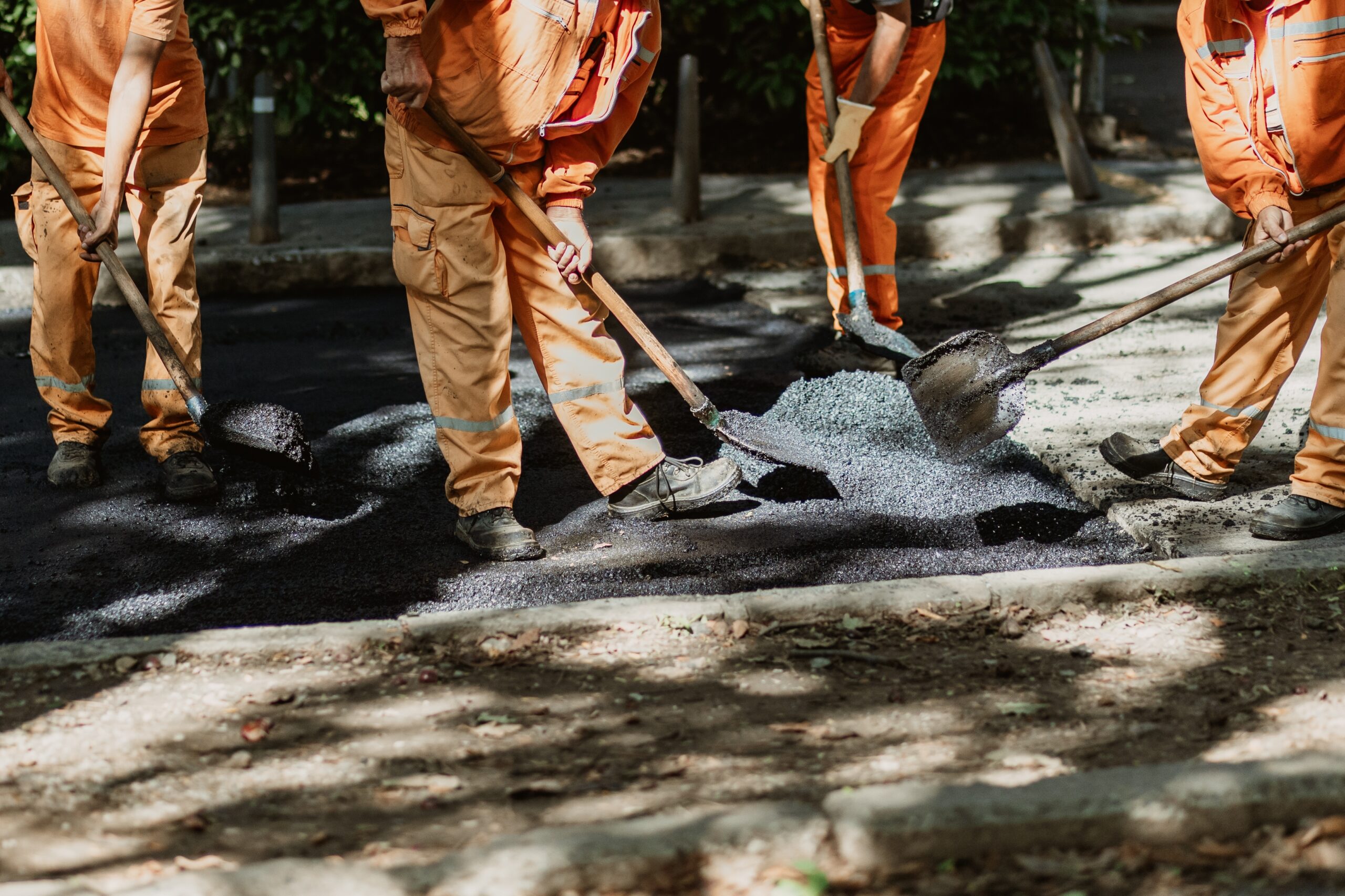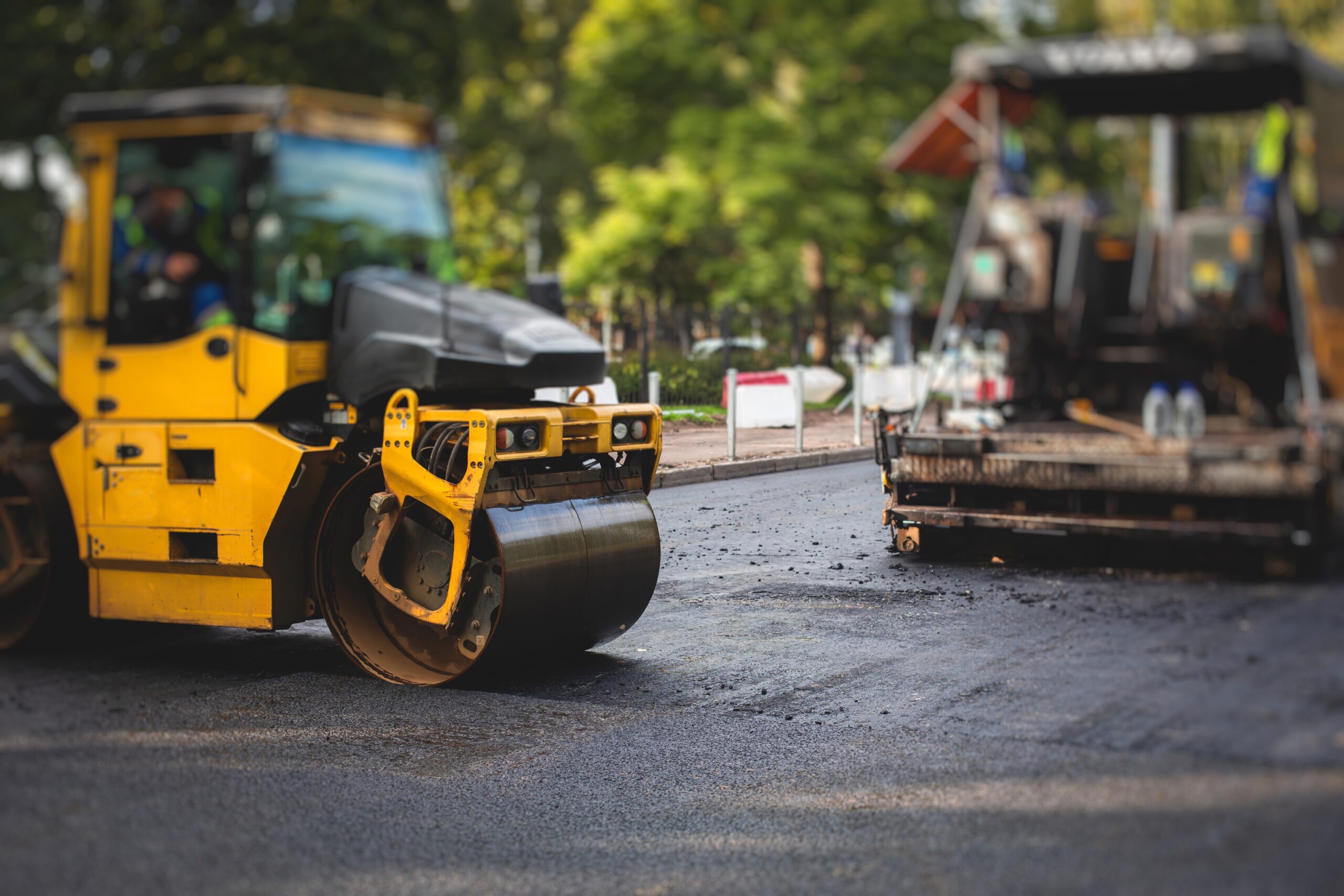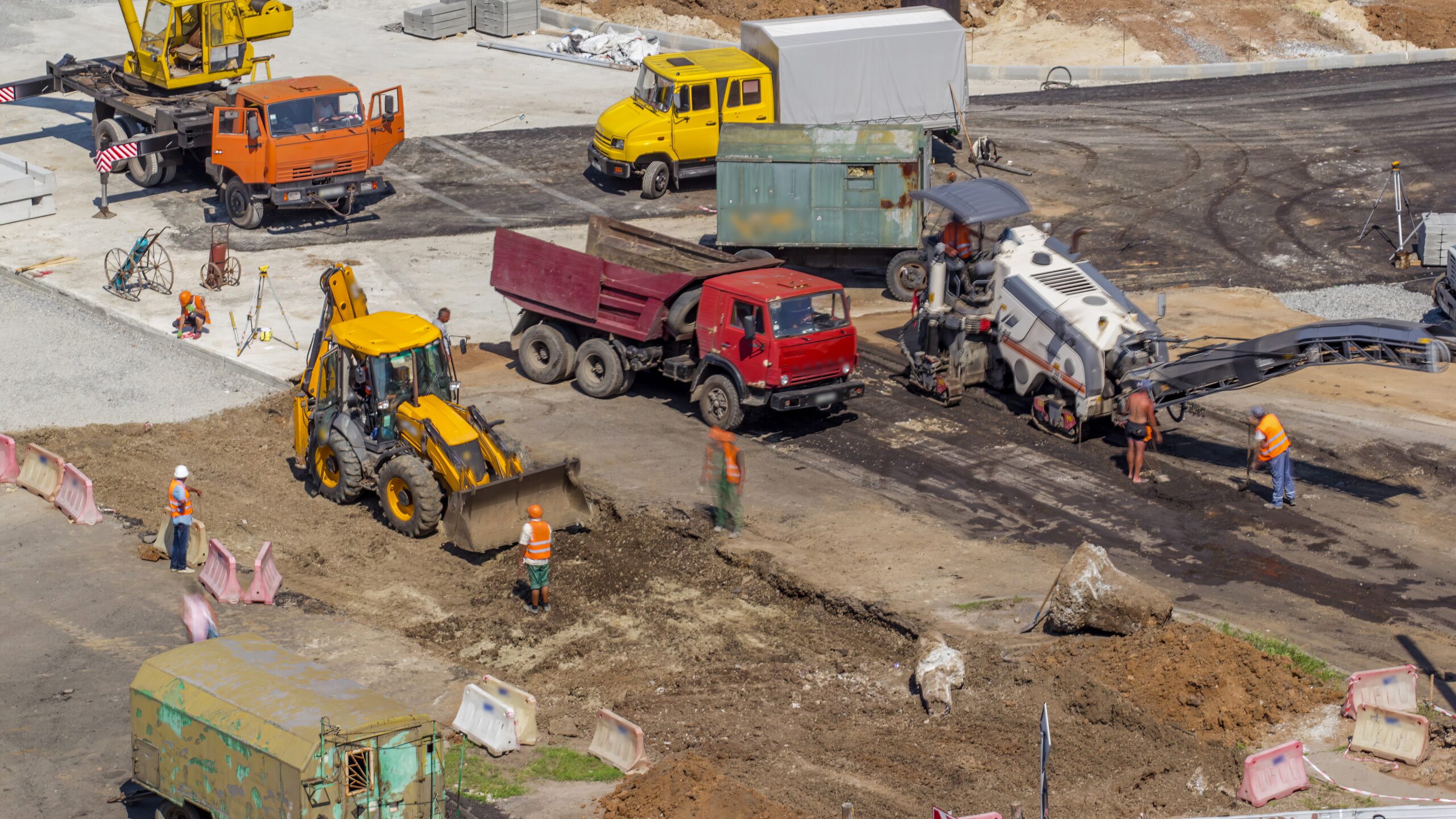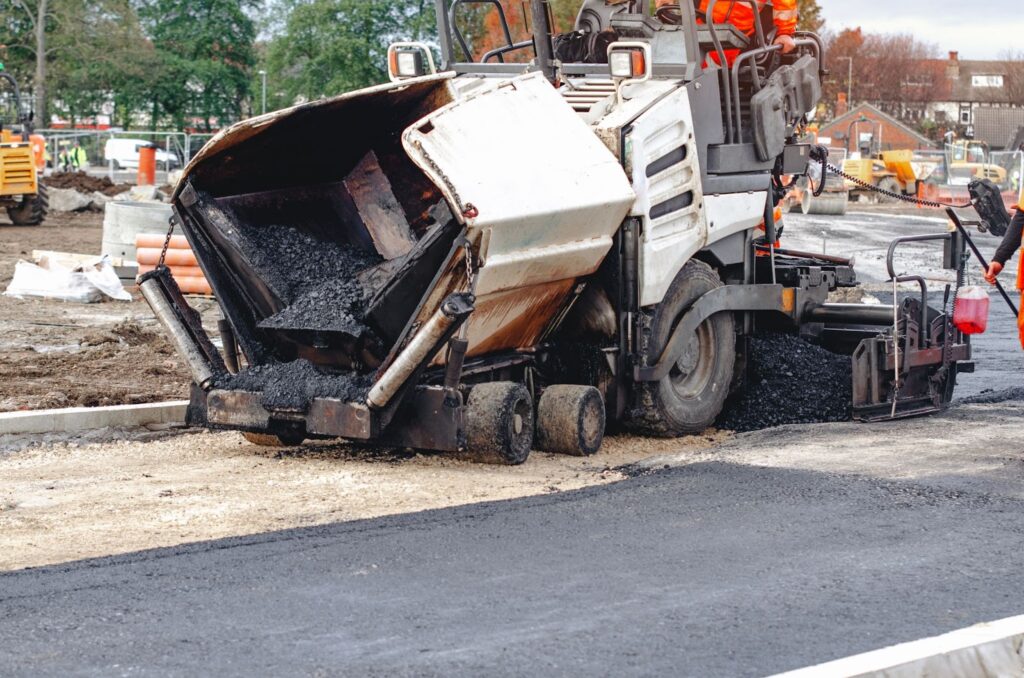
The process of milling and paving asphalt is known as cold milling, followed by overlay. It involves removing the top-worn layer of pavement and applying fresh asphalt. It’s a highly effective method for restoring deteriorated surfaces, improving ride quality, correcting grades and slopes, and recycling reclaimed pavement (RAP).
A Federal Highway Administration (FHWA) study found that increasing in-place compaction to reduce air voids by just 1% can extend pavement life by 10–30%. For a 20-year design life, this yields approximately $83,000 in present-value savings per mile of four-lane asphalt road. The Mill and Pave Services offer a combination of performance improvements, cost-effectiveness, and sustainability, making them a popular and prudent choice for asphalt resurfacing.
Read this blog to understand everything you need to know about milling and paving asphalt in order to make a smart decision for your project.
What is Mill and Pave Asphalt?
Milling and filling, or milling and paving, is a resurfacing procedure in which the more beaten-up or decayed upper layers of asphalt are physically stripped and replaced with a new layer of hot-mix asphalt. This process will recreate structural integrity, improve ride quality, and address surface issues such as cracking, rutting, and potholes without disrupting the underlying builder.
It is economical and strong, and hence, it is used widely in developing major roads and commercial buildings. FWHA states that smart repaving strategies like milling and repaving offer the potential to add 10-15 years of pavement performance life, significantly decreasing the necessity of complete reconstruction, which is costly.
When considering asphalt milling vs full repaving cost, milling offers a more affordable and sustainable alternative, providing similar performance improvements without the heavy price tag of complete repaving.
How does Mill and Pave work?
The process begins with milling machines that grind and remove the deteriorated asphalt layer to a specified depth. The removed material, known as reclaimed asphalt pavement (RAP), is often recycled. After milling, a tack coat is applied to promote adhesion, followed by paving machines that lay and compact a new asphalt construction surface using rollers for optimal density and smoothness.
Benefits of Mill and Pave
Mill and pave is an innovative, budget-friendly solution for extending the life of asphalt surfaces without complete replacement. Key benefits include:
- Lower project costs: According to the Asphalt Institute, the process can be 40–50% more affordable than full-depth reconstruction.
- Preserves the existing foundation: Only the top asphalt layer is replaced, keeping the base layer intact and structurally sound.
- Extends pavement lifespan: As the Federal Highway Administration notes, a properly executed mill and overlay can add 10–15 years of service life.
- Minimizes disruption: Work is completed faster and in phases, reducing downtime for businesses and traffic flow.
With these advantages, mill and pave combines cost-efficiency, durability, and sustainability in one effective paving method.
Key Considerations Before Starting Mill and Pave Asphalt
When planning a mill and pave, pre-project planning is essential before launching the project to save on cost and nurture the best outcomes. Depending on pavement, traffic conditions, and budget, milling may not be the best option. Some of the primary considerations that are of great importance are as follows:
Condition of Existing Asphalt
The first step is to evaluate your pavement’s current condition. Milling is typically best suited in situations where the surface has reached the stage of severe wear out, i.e., cracking, rutting, or raveling. In contrast, the underlying base is well enough maintained to submit to milling. In the event of failure, full-depth reconstruction might be needed in place of base layers.
Traffic Flow and Access Considerations
Traffic volumes, parking requirements, and access routes significantly influence scheduling and project timelines. Coordinating with local authorities and stakeholders is essential to minimize disruptions. If you’re wondering how long milling and paving projects typically take, check out this guide on how long does mill and pave take for a better understanding of project durations.. Here are some practical tips:
- Schedule work during off-peak hours to reduce traffic delays.
- Implement phased construction zones so sections remain open while others are under repair.
- Use clear detour signage to guide drivers and pedestrians efficiently.
- Coordinate with local businesses to maintain customer access.
- Consider night-time milling and paving where noise ordinances and safety allow.
These measures help ensure smoother operations and minimal inconvenience for the public during milling and paving projects.
Cost Factors and Budgeting
Milling and paving are more affordable than complete reconstruction since a significant amount of money is spent on maintaining the base. According to a statement by the Federal Highway Administration, rehabilitation of existing pavements over reconstruction of the same pavement can save the project’s expenditures by 20-40 percent, depending on the site conditions and the rate of material recycling.
When should you choose mill and pavement over complete asphalt replacement?
Choosing the appropriate method of asphalt restoration involves more than fixing the surface damage; it consists of knowing what is under it. Mill and pave is more relevant in selections where only the topsoil has become damaged, yet the base is firm and solid.
Conversely, complete replacement is required when the damage has gone down to the base, compromising the pavement’s integrity in the long term. The Federal Highway Administration has estimated an extended service life of 10-15 years when preserving the existing base with resurfacing techniques, which greatly postpones the eventual necessity of expensive restoration.
Factors Supporting Mill and Pave
If you are considering mill and pave, here are scenarios where it typically excels:
- Minor to moderate surface damage makes mill and pave an ideal choice, especially when issues like cracking, rutting, or potholes do not penetrate the structural base.
- Budget-friendly restoration needs often lead property owners and municipalities to choose milling and paving when full reconstruction is not financially feasible.
- Stable foundation retention is a key reason to opt for this method, as it allows the preservation and reuse of an intact base layer.
- Quick turnaround requirements make milling and paving attractive for projects that need faster completion with minimal disruption to traffic and daily operations.
- This method can meet sustainability goals, as it provides the opportunity to recycle reclaimed asphalt pavement after mill and pave, and reduce environmental impact.
These factors make mill and pave a practical choice for many municipal, commercial, and large-scale road projects.
When Full Replacement is Needed?
In contrast, some conditions go beyond the capabilities of milling and resurfacing. For example:
- Severe structural seal cracking that extends through the surface into the base layers typically requires complete replacement to restore structural integrity.
- Compromised foundation conditions, such as base failures or poor drainage, make resurfacing ineffective and necessitate complete reconstruction.
- Water infiltration damage that weakens or erodes the underlying layers is best addressed through full-depth replacement.
- Significant structural deformation, including large-scale settlement or warping, cannot be corrected through milling alone.
- Design or capacity upgrades that change the pavement’s structure, thickness, or layout require complete replacement rather than resurfacing.
How Long Does a Mill and Pave Job Take?
A mill and pave project timeline is based on size, complexity, and site conditions. Compared to total asphalt replacement, the milling and paving process retains the central layer, drastically reducing the length of the general construction process.
According to the Federal Highway Administration, resurfacing methods often take a small portion of the time needed to perform a total reconstruction, thereby minimizing congestion and job interruption. Planning and collection of the site must be done so that the project is completed promptly.
Timeframe for Small Projects
In smaller areas like driveways, parking lots, or exclusive roads, the mill and pave job can be completed in one to two days, including the milling, paving, and cleanup. The small size of the area, combined with tower traffic and the need for tess equipment, enables a faster turnaround compared to larger projects.
Timeframe for Large-Scale Projects
Streets in municipalities, arterial roads, and highways, on the other hand, require significant planning and implementation. These projects can only last a few days or weeks, depending on several factors, including the pavement length, the number of lanes, and traffic control that might be required.
Factors Influencing Project Duration
Several elements can either shorten or extend the project timeline:
- Weather conditions can cause delays, as heavy rain, extreme heat, or freezing temperatures affect paving quality and curing.
- The existing asphalt condition may require deeper milling or unexpected base repairs, adding extra workdays.
- Equipment type and efficiency play a role; modern, high-capacity machines can complete milling and paving much faster than older equipment.
- Traffic management requirements can slow progress in high-volume areas where phased work or nighttime operations are necessary.
By understanding these variables and planning accordingly, contractors and property owners can set realistic expectations and minimize disruptions for road users or site occupants.
The Equipment Used in the Mill and Paving Asphalt
Milling and paving projects require the proper equipment, as they depend on it. Modern machinery makes the work quicker and achieves a more even, durable finish. The equipment can be chosen differently depending on the size of the work, either a small commercial car parking lot striping or a many-lane highway.
According to the Federal Highway Administration, new milling and paving equipment that uses high-capacity equipment can reduce a project’s completion time by approximately 30 percent compared to older models.
Milling Machine
The milling machine takes the initial step in the process, removing the degraded upper layer of asphalt to an accurate depth. A smaller milling machine effectively manages areas with limited space, e.g., driveways and narrow streets, whereas a large, track-mounted machine would tackle wide highways and general road works.
The machines take the asphalt and grind it using rotating cutting drums with carbide teeth to recycle it into what is known as reclaimed pavement (RAP).
Paving Machines and Rollers
After milling, paving machines spread and mold new hot-mix asphalt on the prepared surface. The paver promotes a uniform thickness and profile, essential for ride quality and durability.
After that, rollers compact the asphalt to the required density, enhancing structural performance and service life. Various rollers, including vibratory, pneumatic, and static, are picked according to the mix design and project specifications.
Environmental Considerations in Mill and Pave Asphalt
Mill and pave techniques significantly benefit the environment compared to full-depth replacement. They are geared towards material reutilization and waste reduction. Mill and pave techniques also use less new aggregates and bitumen since the asphalt remains are reused and recycled.
It also reduces greenhouse gas emissions related to hauling, disposal, and virgin material production, making it a more environmentally friendly decision for asphalt pavement repair.
Recycling and Reusing Asphalt
Recycling old asphalt pavement (RAP) into new asphalt paving projects is among the most significant sustainability advantages of milling. According to the National Asphalt Pavement Association, asphalt is the most recycled commodity in the United States, and over 94 percent of RAP is reused as new pavement mixes.
Reduced Waste and Landfill Use
When milling and paving are done, only the surface layer is eliminated, thus very minimal wastes are produced, unlike full reconstruction, which removes both the asphalt and base layer. Milled materials that are not used instantly in new projects are usually stored for use in the future, which drastically cuts down on the materials that end up in landfills. This environmentally friendly practice enables municipalities and contractors to reduce their disposal costs.
Common Challenges with Mill and Pave Asphalt
Although milling and paving are practical approaches to restoring a roadway and pavement, they have disadvantages that must be addressed to succeed.
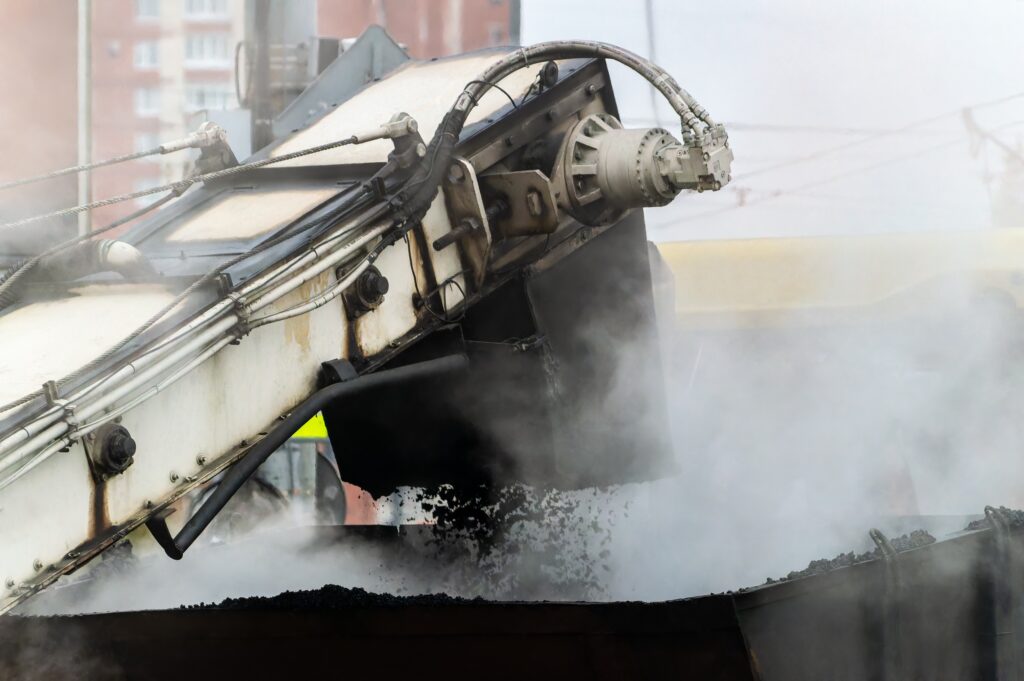
The success of the results is determined by the competence of the operators, conditions of the apparatus, and externalities, such as weather and traffic. Understanding these hurdles enables project managers and proprietors to prepare in advance and reduce inconveniences.
Equipment and Operation Issues
Milling and paving involve accuracy that greatly depends on well-maintained machines and skilled operators. Defects such as hydraulic system malfunctions, worn milling teeth, and uneven pavers can lead to uneven surfaces or project delays.
According to a study by the United States Department of Transportation, even slight variations in milling depth can affect pavement performance over time, which is why using properly calibrated equipment and consistent milling practices is essential for long-term results. The best way to prevent these setbacks is regular maintenance and operator training.
Weather-Related Delays
Milling and paving are heavily dependent on the weather requirement. Delays, loss of asphalt bonding, and compaction can occur due to rain, too much moisture, or freezing temperatures. To achieve the best results, asphalt must typically be laid when the surface is warmer than 50°F (10°C).
Long runs of bad weather are slower, may incur additional costs to reschedule, and may increase the workload. Planning and executing projects in favorable seasons can significantly minimize these risks.
How to Prepare for a Mill and Pave Project?
Understanding and preparation are crucial to a smooth and efficient mill and pave process. Preparing the site and coordinating with the contractors can reduce disruptions and costly mistakes, keeping the project on time.
Site Preparation
All vehicles, debris, and obstacles in the area of work should be removed before the commencement of milling. Highlighting the areas to be milled may assist in orienting the equipment operators and avoiding stripping excess asphalt.
Addressing drainage before paving is equally crucial because poor drainage may lead to water pooling, which reduces the pavement’s life expectancy. A properly planned site will help minimize delays and guarantee a quality outcome.
Communication with Contractors
Effective communication between the property owner and contractors plays an essential role in a successful project. This involves addressing the precise extent of work, setting a feasible schedule, and considering potential interferences, such as the inevitable rerouting of traffic or barring of access. Through open communication, the parties have the opportunity to raise essential issues early, reschedule in case of emergencies, and ultimately deliver a finished surface to meet expectations.
Cost of Mill and Pave Asphalt
The cost of milling and paving asphalt construction ranges from $3 to $6 per square foot, with variations depending on project size, material quality, labor rates, and equipment policies. This range’s affordability makes it preferable to total asphalt replacement, particularly on surfaces with a well-established base layer.
The budget is directly affected by the quality and thickness of materials, as superior-grade asphalt mixtures have higher durability but also cost more. Moreover, per-square-foot cost might be lower on large-scale projects due to economies of scale, and an increase in per-unit cost in smaller projects due to mobilization costs.
Comparing Mill and Pave to Full Asphalt Replacement Costs
Imagine you’re remodeling a room. Complete asphalt replacement is like tearing down the entire structure and rebuilding it from the ground up. This is a costly job, running $8 to $15 per square foot. Mill and pave, on the other hand, is like refinishing the floors. You keep the strong base, strip away only the worn surface, and lay down fresh asphalt. This precision approach usually costs $3 to $6 per square foot, saving you up to 60%.
For a 10,000-square-foot parking lot, that’s the difference between paying roughly $100,000 to $150,000 for a complete rebuild and $30,000 to $60,000 for milling. This is a massive cost gap without sacrificing durability. Many property owners see milling and paving as the smarter investment for high-traffic areas.
Hidden Costs to Watch Out For
Milling and paving may be cost-effective, but unexpected expenses can arise when problems are discovered during the milling process. An example is poor drainage, which may need further grading, or paving may need repair to the subbase.
Additional costs may include additional trucking due to the removal of reclaimed asphalt pavement (RAP) or the use of specialized equipment in case of limited space. Being open to communicating contingencies to the contractor can prevent unwanted budget overruns.
Long-Term Benefits of Mill and Pave Asphalt
Opting for mill and pave is not just about upfront savings. It also offers substantial long-term benefits. According to the Federal Highway Administration (FHWA), a properly executed mill and overlay can extend the lifespan of asphalt pavement by 15 to 20 years. This significantly delays the need for full replacement, making it an attractive choice for property owners seeking value and sustainability.
Extended Pavement Lifespan
Mill and pave repair surface wear only by removing the top layer and replacing it with fresh asphalt without disrupting the base. This solution is more than enough to recover smoothness and restore safety. Still, it also ensures that the pavement’s structural integrity lasts up to 20 years, as long as proper maintenance is considered.
Cost Savings Over Time
Over the long term, milling and paving can reduce lifecycle maintenance costs by minimizing the frequency of large-scale repairs. Businesses and municipalities benefit from fewer disruptions, less downtime, and a reduced need for full-depth reconstruction. These savings make milling and paving a strategic investment for high-traffic areas requiring durability and cost control.
FAQs
How long does a mill and pave project take?
A mill and pave project can often be completed within 1–2 days for small areas like driveways or parking lots. Larger projects, such as commercial parking lots or roadways, may take 3–5 days, depending on size, weather conditions, and complexity. The quick turnaround is one of the main reasons many businesses choose milling over complete replacement.
How much does mill and pave asphalt cost?
Mill and pave projects typically cost $4 to $8 per square foot, depending on location, asphalt thickness, and project size. Complete asphalt replacement can cost $8 to $15 per square foot. By preserving the existing base layer, milling often cuts the cost nearly in half while still delivering a renewed surface.
Can mill and pave be used for all types of asphalt?
Mill and pave works best for asphalt surfaces with a stable foundation, but significant surface wear. It’s ideal for addressing cracks, rutting, and unevenness. However, complete replacement is usually the better long-term solution if the base layer is severely damaged or compromised. A professional inspection can determine which method suits your project best.
Is there any disruption to business or traffic during a mill and pave project?
Some disruption is possible during milling and paving, especially in high-traffic areas. Businesses may experience temporary access limitations, and roads may require partial closures. However, strategic scheduling, such as working during off-peak hours or in sections, can significantly minimize the impact on daily operations.
Ready to Upgrade Your Asphalt?
Throughout this guide, we’ve explored how milling and paving asphalt offer a cost-effective, time-efficient, and long-lasting solution compared to full replacement. From cutting costs nearly in half to extending pavement lifespan by up to 20 years, this method delivers exceptional value for commercial and municipal projects.
If you’re looking for a proven way to restore your asphalt without overspending or causing major disruptions, Asphalt Coatings Company is here to help. Our experienced team specializes in delivering precise, efficient, and durable mill and pave solutions tailored to your needs.

